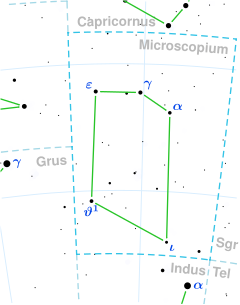HD 204018, also designated as HR 8202, is a visual binary located in the southern constellation of Microscopium. The primary has an apparent magnitude of 5.58, [3] making it faintly visible to the naked eye under ideal conditions. The companion has an apparent magnitude of 8.09. [3] The system is located relatively close at a distance of 176 light years based on Gaia DR3 parallax measurements [2] [4] but is receding with a heliocentric radial velocity of 18.3 km/s . [10] At its current distance, HD 204018's combined brightness is diminished by 0.13 magnitudes due to interstellar dust. [22]
HD 204018A is an Am star with a stellar classification of kA4hF0 VmF6, [6] indicating that it has the calcium K-line of an A4 star, the hydrogen lines of a F0 main-sequence star and the metallic lines of a F6 star. It has 1.73 imes the mass of the Sun [2] and 2.42 times the Sun's radius. [2] It radiates 12.8 times the luminosity of the Sun [2] from its photosphere at an effective temperature of 6,778 K , [13] giving it a yellowish-white hue. At an age of 1.5 billion years, HD 2014018A is estimated to be on the subgiant branch. [5] An alternate model places it on the main sequence at an age of 1,35 billion years. [2] The object spins at a moderate speed with a projected rotational velocity of 85 km/s . [14]
The companion is an F8 main sequence star [9] located 2+1⁄2" away along a position angle of 151°. [23] It has an angular diameter of 0.186±0.035 arcseconds , [17] which yields a radius of 1.09 R☉ at its estimated distance. [16] It has 102% times the mass of the Sun [15] and an effective temperature of 6,235 K . [17] HD 204018B is estimated to be 3.46 billion years old and is slightly metal deficient. [18]
There is a magnitude 12 co-moving companion located 295.3" away from the system along a position angle of 75°. [23] It is a red dwarf with an estimated spectral class of K6 and any orbit would take over a million years. [24]

